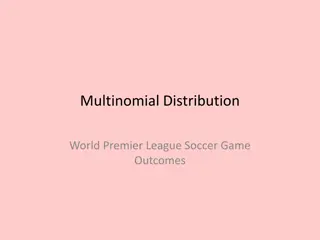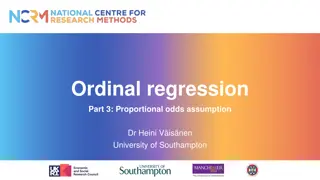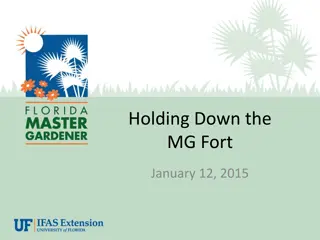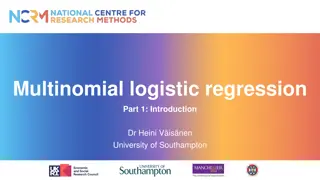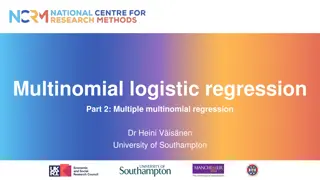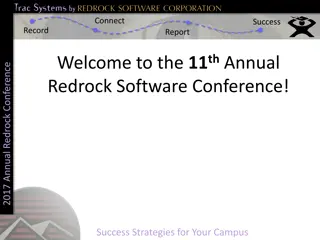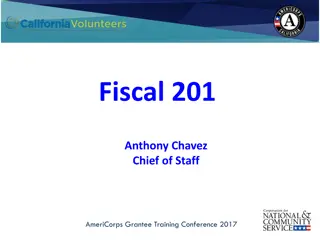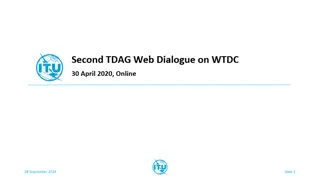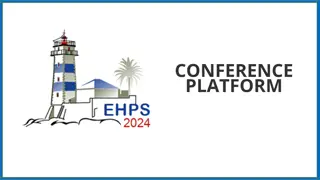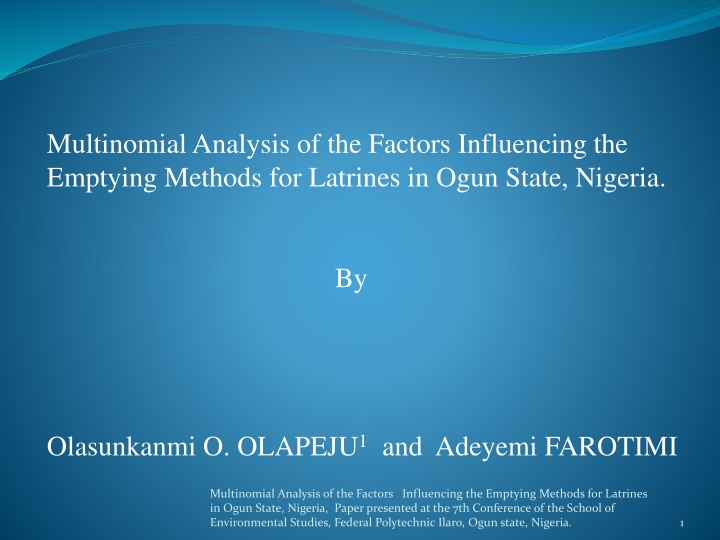
Factors Affecting Latrine Emptying Methods in Ogun State, Nigeria
Explore a study on factors influencing latrine emptying methods in Ogun State, Nigeria, including demographic analysis and fecal waste management strategies. Discover insights into the prevalence of different emptying methods and the educational backgrounds of respondents. Gain valuable knowledge from this research to address sustainable sanitation practices and promote public health.
Download Presentation

Please find below an Image/Link to download the presentation.
The content on the website is provided AS IS for your information and personal use only. It may not be sold, licensed, or shared on other websites without obtaining consent from the author. If you encounter any issues during the download, it is possible that the publisher has removed the file from their server.
You are allowed to download the files provided on this website for personal or commercial use, subject to the condition that they are used lawfully. All files are the property of their respective owners.
The content on the website is provided AS IS for your information and personal use only. It may not be sold, licensed, or shared on other websites without obtaining consent from the author.
E N D
Presentation Transcript
Multinomial Analysis of the Factors Influencing the Emptying Methods for Latrines in Ogun State, Nigeria. By Olasunkanmi O. OLAPEJU1 and Adeyemi FAROTIMI Multinomial Analysis of the Factors Influencing the Emptying Methods for Latrines in Ogun State, Nigeria, Paper presented at the 7th Conference of the School of Environmental Studies, Federal Polytechnic Ilaro, Ogun state, Nigeria. 1
Global Strategies for Eradicating Open Defecation
Faecal Waste Within the Context of Circular Economy and Challenges Faecal Waste have Applications in the Production of Biochar, Biogas, Construction Materials Addictives,& Agriculture Households in the study area still use unsustainable(NRM) faecal waste management methods. This does not just impinge on recoverability and reuse but also have health consequences. Therefore, the study is an attempt to investigate the factors influencing latrines emptying methods in the study Area.
Methods 4 level multistage sampling technique 5 sampling polling units in each of the senatorial sampling areas 11, 10, 12 households within 1km of the PUs in each of Likosi, Ogijo/Likosi ward Ilaro I; Sodeke/Isale Ijeun II 55, 50, and 60 questionnaires(160) were administered in 1.1:1.0:1.23, which reflects the variance in population of 1,250,435(33%), 1,112,761(30%), and 1,387,944(37%) for Ogun East, Ogun West and Ogun Central, respectively.
Demographic Analysis The male gender accounts for the majority of respondents (64.2%) in the study area which is largely inhabited by Yoruba speaking population. The absolute ages of respondents varied from 27 to 78 years, with a median age of 52 years and a standard deviation of 12.8. Moreover, 79.5 % of respondents had secondary education as their highest educational qualification. A great percentage of the respondents were actively engaged in the economy (97.4%) as artisans, civil servants and private sector employees. However, the greatest number of respondents (45.9%) was ranked in the lower-middle class. Others ranked in the upper- medium class accounted for 26.1%, floating class (12.1%) and the upper class (4.8%).
Faecal Waste Emptying Methods Emptying with the aid of manual emptiers (20.1%) emptying with mechanical emptiers (31.5%) and the non-recovery management (NRM) method (48.4%).
Analysis of The Factors Influencing Households Faecal Waste Emptying Methods This multinomial logistic regression analysis adopted revealed key information: The first category (Empty the Pit with the Aid of Manual Emptiers), at p-value 0.035, only the variable awareness of faecal waste reuse (DREUSE) was significant. Other variables and their categories had insignificant values. For the second category, awareness of faecal waste reuse (DREUSE), Lower-middle-class Income category (INCCAT3) and Simple Pit latrines (LATTEC 2) at 0.018, 0.00, and 0.00, respectively were significant.. For the third category, only the sub-categories of income class such as floating class (INCCAT2) and upper-middle class(INCCAT4), both at 0.00, were significant.
Relative Risks Ratio For the first category, the RRR for a unit increase in the scale of the awareness of faecal waste reuse (DREUSE) is 4.454 . For the second category, the RRR for a unit increase in the scale of the awareness of faecal waste reuse (DREUSE) is 5.631 . Moreover, the RRR of switching from the highest income class (INCCAT 4) level to the lower-middle level (INCCAT 3) is 9.547E9. This means that the propensity of households to use mechanical emptying option versus shrinking sludge with strong acids increases by 9.547E9 from the highest income class(INCCAT 4) level to the lower-middle level(INCCAT 3). Also, the RRR of switching from the most advanced latrine technology of WC-to Sewer (LATTEC 7) to simple pit latrine (LATTEC 2) is 0.2. This means that the propensity of households to use mechanical emptying option versus shrinking sludge with strong acids decreases by 0.2 from WC-to Sewer (LATTEC 7) to simple pit latrine(LATTEC 2). However, for the third category, the RRR of switching from the highest income class (INCCAT 4) level to the lower-middle level (INCCAT 3) is 9. 219E8. The RRR of switching from the highest income class (INCCAT 4) level to the floating class (INCCAT 2) is 2.677E8.
Conclusion As evident in the multinomial regression equations, awareness of reuse, income category, and latrine technology featured prominently as the most significant factors. enlightenment campaigns aimed at sensitising households on the nexus between the reusability and emptying methods Further, there is a need for municipal authorities to encourage the adoption of simple onsite low-cost technologies such as urine diversion dry toilets (UDDTs) that aids reuse.




